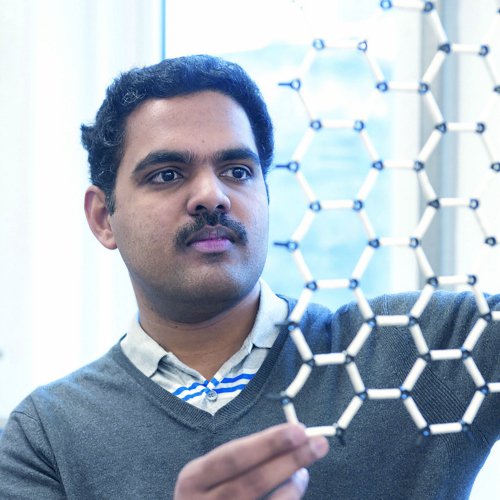Manchester: bringing clean water to the world
Today nearly one fifth of the world’s population – 1.2 billion people – live in areas plagued by water scarcity. However, a revolution in water filtration developed at The University of Manchester could provide a much-needed solution, with ready access to clean water finally a real possibility for the world.
Global problem: access to clean drinking water
Research beacon breakthroughs
Find out how world-class academic research is commercialised by scientists, engineers, medical professionals, business leaders and policymakers at Manchester.
Around 71% of the Earth’s surface is covered by water, of which 96.5% is contained in saltwater oceans.
Desalination technologies could bring fresh water to everyone, but are currently very costly.
Graphene-oxide membranes developed at Manchester’s National Graphene Institute (NGI) were initially used to filter out small nanoparticles and organic molecules from water.
Common salts used in desalination technologies, however, could not be sieved.
The membranes would become slightly swollen when they were immersed in water, which meant smaller salts could flow through the expanded membrane along with the water.
Manchester solution: affordable desalination
Manchester researchers in our NGI Membranes Lab developed a strategy to avoid the swelling of the graphene-oxide membrane in water. They enabled the pore size in the membrane to be precisely controlled – and common salts to be sieved out of salty water – making it safe to drink.
“Manchester’s pioneering spirit has made the UK a world leader in the field of advanced materials. Our centres of excellence – from our current NGI to the forthcoming Graphene Engineering Innovation Centre and Henry Royce Institute – are attracting the world’s best physicists, chemists, biologists, material scientists and engineers, all working together to develop the life-changing materials of the future.”
Rahul Nair / Professor of Materials Physics
Creating scalable membranes with uniform pore size down to atomic scale is a huge step forward, opening new possibilities for improving the efficiency – and lowering the costs – of desalination technology across the globe.
Professor Rahul Nair is one of the world’s foremost graphene membrane scientists and a member of the team who made the research breakthrough. He says: “This is the first clear-cut experiment in this regime. We also demonstrated that there are realistic possibilities to scale up the described approach and mass-produce graphene-based membranes with required sieve sizes.”

Fellow team member and PhD student Jijo Abraham adds: “The developed membranes are not only useful for desalination, but also have the potential to filter out ions according to their sizes, which could lead to developments in gas separation technologies.”
Professor Nair says: “Manchester’s pioneering spirit has made the UK a world leader in the field of advanced materials.
"Our centres of excellence – from our current NGI to the forthcoming Graphene Engineering Innovation Centre and Henry Royce Institute – are attracting the world’s best physicists, chemists, biologists, material scientists and engineers, all working together to develop the life-changing materials of the future.”
Life-changing impacts
With the potential to revolutionise water filtration across the globe, the University’s new technology could:
- bring affordable water filtration to countries that cannot afford large-scale desalination plants, giving clean water to millions of people who need it most;
- offset the effects of climate change, or natural disasters such as severe flooding, on modern cities’ water supplies, providing affordable and sustainable alternative water solutions.
Find out more
Read the research paper:
- 'Tunable sieving of ions using graphene oxide membranes', Nature Nanotechnology, 2017
Meet the researcher:
- Professor Rahul Nair, Professor of Materials Physics, NGI
Watch the revolutionary applications of graphene:
